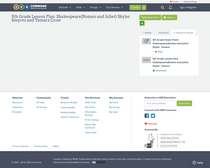Learning Domain: Reading for Literature
Standard: Cite strong and thorough textual evidence to support analysis of what the text says explicitly as well as inferences drawn from the text.
Degree of Alignment:
Not Rated
(0 users)
Learning Domain: Reading for Literature
Standard: By the end of grade 9, read and comprehend literature, including stories, dramas, and poems, in the grades 9–10 text complexity band proficiently, with scaffolding as needed at the high end of the range. By the end of grade 10, read and comprehend literature, including stories, dramas, and poems, at the high end of the grades 9–10 text complexity band independently and proficiently.
Degree of Alignment:
Not Rated
(0 users)
Learning Domain: Reading for Literature
Standard: Analyze how complex characters (e.g., those with multiple or conflicting motivations) develop over the course of a text, interact with other characters, and advance the plot or develop the theme.
Degree of Alignment:
Not Rated
(0 users)
Learning Domain: Reading for Literature
Standard: Determine the meaning of words and phrases as they are used in the text, including figurative and connotative meanings; analyze the cumulative impact of specific word choices on meaning and tone (e.g., how the language evokes a sense of time and place; how it sets a formal or informal tone).
Degree of Alignment:
Not Rated
(0 users)
Learning Domain: Reading for Literature
Standard: Analyze how an author draws on and transforms source material in a specific work (e.g., how Shakespeare treats a theme or topic from Ovid or the Bible or how a later author draws on a play by Shakespeare).
Degree of Alignment:
Not Rated
(0 users)
Learning Domain: Reading Literature
Standard: Cite strong and thorough textual evidence to support analysis of what the text says explicitly as well as inferences drawn from the text.
Degree of Alignment:
Not Rated
(0 users)
Learning Domain: Reading Literature
Standard: By the end of grade 9, read and comprehend literature, including stories, dramas, and poems, in the grades 9-10 text complexity band proficiently, with scaffolding as needed at the high end of the range. By the end of grade 10, read and comprehend literature, including stories, dramas, and poems, at the high end of the grades 9-10 text complexity band independently and proficiently.
Degree of Alignment:
Not Rated
(0 users)
Learning Domain: Reading Literature
Standard: Analyze how complex characters (e.g., those with multiple or conflicting motivations) develop over the course of a text, interact with other characters, and advance the plot or develop the theme.
Degree of Alignment:
Not Rated
(0 users)
Learning Domain: Reading Literature
Standard: Determine the meaning of words and phrases as they are used in the text, including figurative and connotative meanings; analyze the cumulative impact of specific word choices on meaning and tone (e.g., how the language evokes a sense of time and place; how it sets a formal or informal tone).
Degree of Alignment:
Not Rated
(0 users)
Learning Domain: Reading Literature
Standard: Analyze how an author draws on and transforms source material in a specific work (e.g., how Shakespeare treats a theme or topic from Ovid or the Bible or how a later author draws on a play by Shakespeare).
Degree of Alignment:
Not Rated
(0 users)
Cluster: Key Ideas and Details.
Standard: Cite strong and thorough textual evidence to support analysis of what the text says explicitly as well as inferences drawn from the text.
Degree of Alignment:
Not Rated
(0 users)
Cluster: Range of Reading and Level of Text Complexity.
Standard: By the end of grade 9, read and comprehend literature, including stories, dramas, and poems, in the grades 9–10 text complexity band proficiently, with scaffolding as needed at the high end of the range. By the end of grade 10, read and comprehend literature, including stories, dramas, and poems, at the high end of the grades 9–10 text complexity band independently and proficiently.
Degree of Alignment:
Not Rated
(0 users)
Cluster: Key Ideas and Details.
Standard: Analyze how complex characters (e.g., those with multiple or conflicting motivations) develop over the course of a text, interact with other characters, and advance the plot or develop the theme.
Degree of Alignment:
Not Rated
(0 users)
Cluster: Craft and Structure.
Standard: Determine the meaning of words and phrases as they are used in the text, including figurative and connotative meanings; analyze the cumulative impact of specific word choices on meaning and tone (e.g., how the language evokes a sense of time and place; how it sets a formal or informal tone).
Degree of Alignment:
Not Rated
(0 users)
Cluster: Integration of Knowledge and Ideas.
Standard: Analyze how an author draws on and transforms source material in a specific work (e.g., how Shakespeare treats a theme or topic from Ovid or the Bible or how a later author draws on a play by Shakespeare).
Degree of Alignment:
Not Rated
(0 users)



Comments